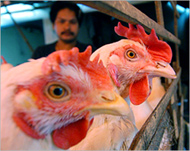Meat can be ‘grown’ in laboratories
Laboratories using new tissue engineering technology might be able to produce meat that is healthier for consumers and cut down on pollution produced by factory farming.

While NASA engineers have grown fish tissue in lab dishes, no one has seriously proposed a way to grow meat on commercial levels until now.
But a new study conducted by University of Maryland doctoral student Jason Matheny and his colleagues describe two possible ways to do it.
Writing in the journal Tissue Engineering on Wednesday, Matheny said scientists could grow cells from the muscle tissue of cattle, pigs, poultry or fish in large flat sheets on thin membranes.
These sheets of cells would be grown and stretched, then removed from the membranes and stacked to increase thickness and resemble meat.
Plan B
Using another method, scientists could grow muscle cells on small three-dimensional beads that stretch with small changes in temperature. The resulting tissue could be used to make processed meat such as chicken nuggets or hamburgers.
|
“Cultured meat could also reduce the pollution that results from raising livestock, and you wouldn’t need the drugs that are used on animals raised for meat” Jason Matheny, |
“There would be a lot of benefits from cultured meat,” Matheny said in a statement. “For one thing, you could control the nutrients.”
Meat is high in omega-6 fatty acid, which is desirable, but not in large amounts. Healthful omega-3 fatty acids, such as those found in walnuts and fish oils, could be substituted.
“Cultured meat could also reduce the pollution that results from raising livestock, and you wouldn’t need the drugs that are used on animals raised for meat,” Matheny said.
Perceived benefits
Raising livestock requires million of gallons of water and hundreds of acres of land. Meat grown from tissue would bypass those requirements.
The demand for meat is increasing worldwide, Matheny said. “China’s meat demand is doubling every ten years,” he said.
 |
|
Poultry consumption in India has |
“Poultry consumption in India has doubled in the last five years.”
Writing in this month’s Physics World, British physicist Alan Calvert calculated that the animals eaten by people produce 21% of the carbon dioxide that can be attributed to human activity.
He recommends people switch to a vegetarian diet as a way to battle global warming.
“Worldwide reduction of meat production in the pursuit of the targets set in the Kyoto treaty seems to carry fewer political unknowns than cutting our consumption of fossil fuels,” he said in a statement.
The Kyoto treaty is a global agreement aimed at reducing production of so-called greenhouse gases such as carbon dioxide that help fuel global warming.